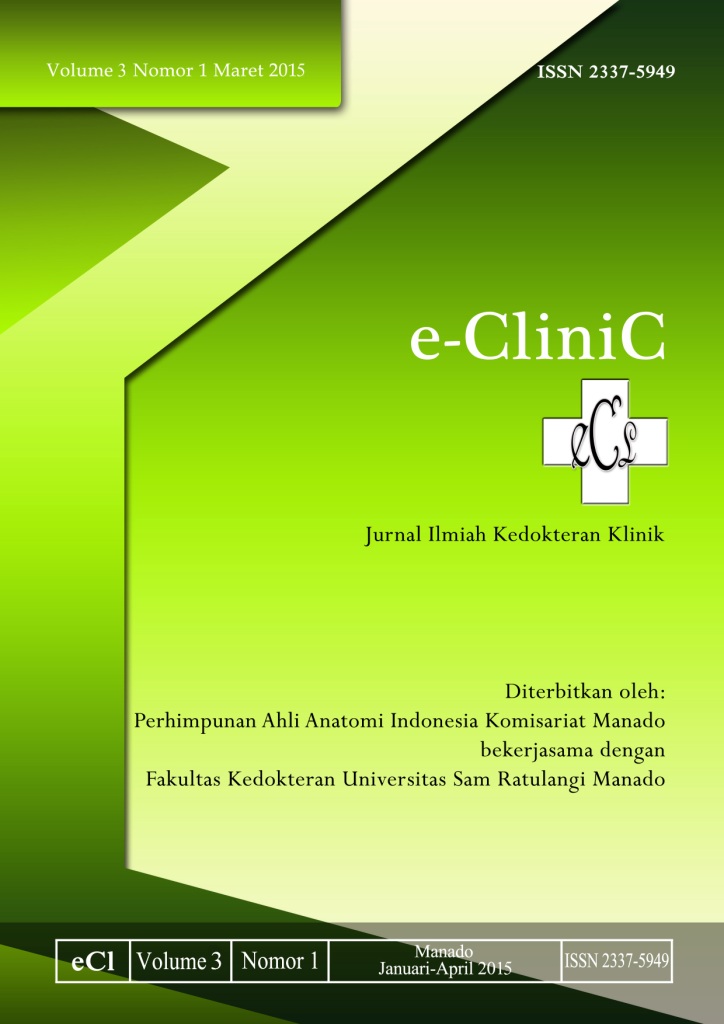GAMBARAN HASIL PEMERIKSAAN CT SCAN KEPALA PADA PENDERITA STROKE HEMORAGIK DI BAGIAN RADIOLOGI FK. UNSRAT/SMF RADIOLOGI BLU RSUP PROF. DR. R. D. KANDOU MANADO
DOI:
https://doi.org/10.35790/ecl.v3i1.6746Abstract
Abstract: Hemorrhagic stroke is a spontaneous blood vessel bursts inside the brain. The main cause is chronic hypertension and the presence of degeneration of cerebral blood vessels. Bleeding can occur in the brain and the subarachnoid space due to rupture of an artery or rupture of the aneurysm. At a stroke, a CT scan is the gold standard examination to distinguish infarction with bleeding, because CT scan can give a very clear picture of the head of the intracranial space persisted as cerebral infarction, intracranial hemorrhage, and hemorrhagic stroke. So it can be helpful to diagnose the disease and neurological disorders. The purpose of this study is to cognize the distribution of hemorrhagic stroke patients who performed a head CT scan at The Department of Radiology of FK UNSRAT / SMF Radiology of BLU Prof. Dr. R. D. Kandou Manado. This is a retrospective descriptive study by using secondary data coming from hemorragic stroke patients medical records in the Department of Radiology of BLU Prof. Dr. R. D. Kandou Manado on the period time from May to October 2014. Patients admitted inclusion criteria age between 30-80 years old, proven hemorrhagic stroke based on history, physical examination and investigations of doctors. The results showed that the total number of head CT Scans are 296 patients and more showed abnormal picture (58.1%) compared with the normal picture (41.9%), there are 64 patients with abnormal CT Scan picture results of hemorrhagic stroke (37.2% ), patients with hemorrhagic stroke are more common in males (65.6%), most in the age group of the early elderly betweeb 46-55 years old (40.6%) with most bleeding type of intracerebral hemorrhage (87.5%). Conclusion: Patient that comes with hemorrhagic stroke case or recurrent stroke should undertake a CT Scan of head to assist diagnose and later on can identify the type of bleeding caused by the stroke.
Keywords: head CT scan, haemorrhagic stroke
Abstrak: Stroke hemoragik adalah perdarahan spontan di dalam otak. Penyebab utamanya adalah hipertensi kronik dan adanya degenerasi pembuluh darah cerebral. Perdarahan dapat terjadi di dalam otak dan ruang subaraknoid karena ruptur dari arteri atau ruptur dari aneurisma. Pada penyakit stroke, CT Scan merupakan pemeriksaan baku emas untuk membedakan infark dengan perdarahan, karena CT Scan dapat memberikan gambaran kepala yang sangat jelas tentang proses desak ruang intrakranial seperti infark otak, perdarahan intrakranial, dan stroke hemoragik. Sehingga dapat membantu penegakan diagnosis penyakit dan kelainan neurologik. Tujuan penelitian ini untuk mengetahui distribusi penderita stroke hemoragik yang dilakukan pemeriksaan CT Scan kepala di Bagian Radiologi FK UNSRAT/SMF Radiologi BLU RSUP Prof. Dr. R. D. Kandou Manado. Penelitian ini merupakan penelitian deskriptif retrospektif dengan memanfaatkan data sekunder berupa rekam medik pasien stroke hemoragik di Bagian Radiologi BLU RSUP Prof. Dr. R. D. Kandou Manado periode Mei-Oktober 2014. Pasien yang masuk kriteria inklusi yaitu usia 30-80 tahun, terbukti stroke hemoragik berdasarkan anamnesis, pemeriksaan fisik dan penunjang oleh dokter. Hasil pemeriksaan CT Scan kepala berjumlah 296 pasien dan lebih banyak menunjukkan gambaran abnormal (58,1%) dibandingkan gambaran normal (41,9%), pada gambaran abnormal terdapat 64 penderita dengan hasil CT Scan gambaran stroke hemoragik (37,2%), penderita stroke hemoragik lebih banyak terjadi pada laki-laki (65,6%), paling banyak pada kelompok umur lansia awal 46-55 tahun (40,6%) dengan tipe perdarahan paling banyak yaitu perdarahan intraserebral (87,5%). Simpulan : Penderita yang datang dengan keluhan stroke hemoragik atau stroke berulang sebaiknya melakukan pemeriksaan CT Scan kepala untuk membantu diagnosis dan dapat diketahui tipe perdarahan dari stroke tersebut.
Kata kunci : CT scan kepala, stroke hemoragik
Downloads
Published
How to Cite
Issue
Section
License
COPYRIGHT
Authors who publish with this journal agree to the following terms:
Authors hold their copyright and grant this journal the privilege of first publication, with the work simultaneously licensed under a Creative Commons Attribution License that permits others to impart the work with an acknowledgment of the work's origin and initial publication by this journal.
Authors can enter into separate or additional contractual arrangements for the non-exclusive distribution of the journal's published version of the work (for example, post it to an institutional repository or publish it in a book), with an acknowledgment of its underlying publication in this journal.
Authors are permitted and encouraged to post their work online (for example, in institutional repositories or on their website) as it can lead to productive exchanges, as well as earlier and greater citation of the published work (See The Effect of Open Access).







